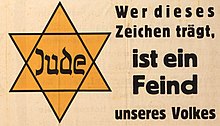Slogan of the week
The slogan of the week was a wall newspaper of the Reich Propaganda Management of the NSDAP , which was intended for public notice. More than 400 issues appeared between April 1936 and February 1943.
Editing
A first edition appeared on March 16, 1936 as the "campaign newspaper" shortly before the Reichstag election of March 29, 1936 , which was connected with a subsequent "referendum on the authorization to occupy the Rhineland ". It was then decided to keep this propaganda tool, and from April 1, 1936, “The Parole of the Week” appeared regularly as a new wall newspaper. In the next editions, the words “Parole of the week” were conspicuously emphasized by color and size, but finally only mentioned in small print.
The Reich Propaganda Leadership of the NSDAP, head office “Active Propaganda,” based in Munich was the publisher. The imprint of the first issues reads: “Zentralverlag der NSDAP, Munich, responsible. Walter Schulze , Munich, print: M. Müller & Sohn KG, Munich. ”Under the heading“ The slogan of the week ”was the subheading“ Party official wall newspaper of the NSDAP. ”At the end of 1938, the imprint“ Zentralverlag der NSDAP, Frz. Rather Nachf., Munich "called. In 1940 Hannes Kremer was responsible for the content , from 1942 W. Wächter .
distribution
The large-format party official propaganda newspaper was intended exclusively for posting. Simple and inexpensive to produce wooden panels were recommended for this. Because of the weekly changing notice, glass covers or protective grids are not required. The boards should be set up in public places, in waiting rooms, post offices, hotels, restaurants and in larger businesses.
The weekly wall newspaper was not distributed free of charge, but had to be requested for a monthly subscription price of 0.80 Reichsmarks. These costs were often covered by party branches. In privately run businesses, voluntary donations from the owners were expected. However, the hoped-for widespread use did not initially materialize. Most contemporary witnesses only remember the attack on public buildings.
The reports from the Reich reported in 1940 that the wall newspaper was read with great interest by the population and that it had an effect above all on those layers who did not read the newspaper every day. In Alsace, the head of the civil administration made 1500 copies available free of charge every week.
to form
The style and format of the wall newspaper changed several times. The first editions were 135 cm by 54 cm and resemble three newspaper sheets placed side by side. It was soon changed to a new format of 120 cm by 84 cm, which allowed a current, highlighted headline under the prominent title “Password of the Week”. From the end of 1938, the original main title only appeared in the small print and dwindled in favor of content-related headlines. The propaganda newspaper was made more bold and colorful, it contained large-format photos and graphics.
Obviously, there were at times greatly reduced gummed formats that could be stuck to international mail for propaganda purposes. With these reductions, which took up the color scheme of the original edition, part of the text was omitted.
Content
In the first few years, commemorative and public holidays of the “National Socialist Movement” were often discussed or the achievements and successes of the new regime highlighted. Headlines were for example the overcoming of unemployment (1936/16), the peasantry (1936/27), the four-year plan (1936/33), the German Christmas (1936/38), the day of the seizure of power (1937/5), the Reich Party Rally 1937 (1937/37), the Winter Relief Organization (1937/41) and the manhood of a well-armed people of fighters (1938/27). Occasionally - not yet with full aggressiveness - incited against Freemasons, Jews, churches and plutocrats , for example the Jewish agitation (1937/12) was made a topic.
According to the judgment of Franz-Josef Heyens, the editions of the first three years represent a “very informative compendium of National Socialist ideas and National Socialist everyday life”. After the outbreak of war, however, sheer hatred and pure agitation, pathetic glorification and fanatical battle slogans predominated. "Documents of treason" was quoted on July 9, 1941 from allegedly captured documents that are supposed to prove an attack planned by the Soviet Union.
Counter-propaganda
From the end of 1942, English counter-propaganda began using small-format forgeries in France, such as one with the designation “Parole of the week, No. 46/1943, Zentralverlag der NSDAP, Munich”. The scaled-down poster contained an invented quote; Adolf Hitler allegedly said on November 8, 1943: “If the German people were to collapse under the current burden, I would not cry a tear after him. It would deserve its fate ”. Almost all of the eighteen fake stickers that have become known come from the time when the German “Parole of the week” had already stopped appearing.
literature
- Franz-Josef Heyen: slogan of the week. A wall newspaper in the Third Reich 1936-1943. dtv, Munich 1983, ISBN 3-423-02936-6 .
Web links
- Black propaganda on Psywar.org (English)
Individual evidence
- ^ Franz-Josef Heyen: Slogan of the week. A wall newspaper in the Third Reich 1936-1943. dtv Munich 1983, ISBN 3-423-02936-6 , pp. 7 and 19.
- ^ Franz-Josef Heyen: Slogan of the week. A wall newspaper in the Third Reich 1936-1943. dtv Munich 1983, ISBN 3-423-02936-6 , p. 10.
- ↑ Heinz Boberach (Ed.): Messages from the Reich. The secret situation reports of the SS Security Service 1939-1945. Herrsching 1984, ISBN 3-88199-158-1 , Vol. 4, p. 912 / Vol. 5, p. 1684.
- ↑ a b Black Propaganda (English, accessed February 1, 2016).
- ↑ See for example nos. 19/1941 and 19/1941 at calvin-edu: Parole of the week - illustrations (English, accessed on February 1, 2016).
- ^ Franz-Josef Heyen: Slogan of the week. A wall newspaper in the Third Reich 1936-1943. dtv Munich 1983, ISBN 3-423-02936-6 , p. 17.
- ^ Franz-Josef Heyen: Slogan of the week. A wall newspaper in the Third Reich 1936-1943. dtv Munich 1983, ISBN 3-423-02936-6 , p. 19.


